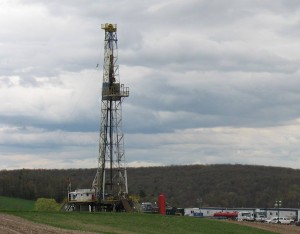New Technology Treats Frack Water in Pennsylvania
-
Susan Phillips
Seven years ago, Ned Godshall says a business associate who ran a large independent oil and gas company came to him with a problem. Godshall says he referred to the problem as “produced water.” Today that water is more commonly known as frack waste water. It includes water that’s shot down into a well at high pressure to help free the gas. Going down, the water contains sand and chemicals. When it returns, it also brings with it the naturally occurring salts and radioactive materials that lie deep within the earth. Treating and disposing that water remains a concern for regulators, environmentalists and residents who live near drilling sites. Godshall, who has a degree in material science from Drexel University, but says he’s no water expert, wanted to figure out what to do with the millions of gallons of wastewater produced each day by gas drilling.
“I realized it was a multi-billion dollar issue for all companies not just the smaller independents. People were trying to deal with highly brackish water with reverse osmosis.”
Godshall says the brackish water, which also contains bromides, clogs up filters in the reverse osmosis process. He says his own innocence, or ignorance, led him to experiment with what’s known as “thermal distillation.” That’s a technique used to desalinate salty water. But up until now, engineers thought they had to use pressure, which combined with saltwater, requires expensive metallic materials. Instead, Godshall created a method that would not use pressure, so the distillers can be made of cheap plastic. And they use waste heat from other industries to boil the water.
“We’re making a big still out of plastic. Everyone says, why didn’t someone see that before. We saw it, frankly, because I was not a water expert and I asked why.”
Godshall’s company, Altela, has a plant in Williamsport that has 48 thermal distillation units, which can treat 130,000 gallons of frack water a day. Each one is 13 feet tall, three feet wide, and three feet deep.
“Imagine a big tall refrigerator made out of plastic. Inside the plastic, we’re evaporating water on one side, using air and low-grade heat, not electricity. We generate the heat by boiling water and making steam.”
The Altela plant, unlike the state’s municipal sewage treatment facilities, has a permit from the Pennsylvania Department of Environmental Protection to discharge the treated frack water back into rivers and streams. But Godshall says, that’s not happening. Instead, the gas companies are reclaiming it and using it to frack more wells. This is what the companies call recycling.
So what happens to the salts, bromides and other toxic chemicals? About 5 to 10 percent of the water that comes into the plant needs to be disposed of in deep injection wells in Ohio.
“We don’t really take the bad stuff out of the water,” says Godshall. We take out 90 percent of the volume, which is good clean water molecules…. All the bad stuff, man-made or naturally occurring, stays behind.”
Godshall says his process reduces the amount of contaminated water that has to go back down into the earth. He has plans to open up two new plants in Pennsylvania. Together they would be able to treat more than a million gallons of frack water each day.

















